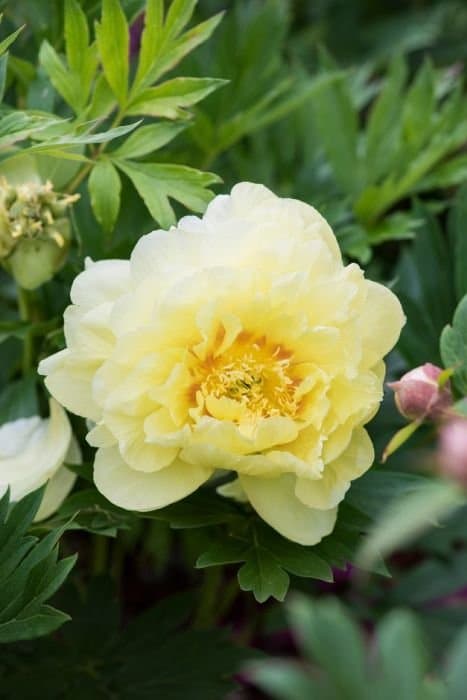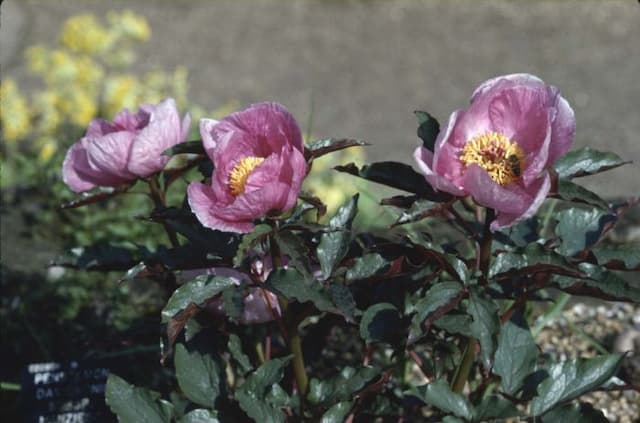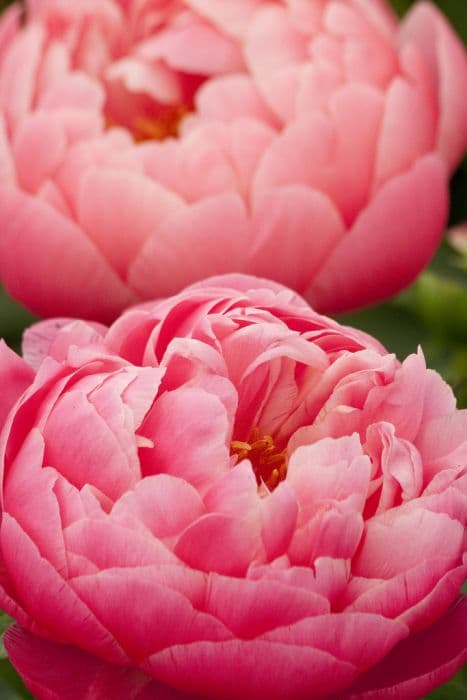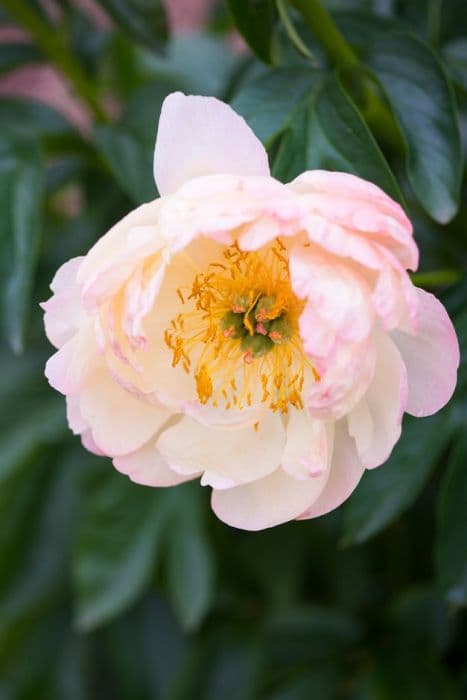Tree peony Paeonia × suffruticosa 'Rimpo' (S)

ABOUT
The 'Rimpo' variety of tree peonies is a striking ornamental plant renowned for its showy and fragrant blooms. These flowers can be quite large and are characterized by a stunning blend of colors that may include shades of pink, purple, and cream. The sumptuous petals, often intricately ruffled or deeply lobed, surround a cluster of conspicuous golden-yellow stamens that add to the visual appeal of each flower. The blossoms typically appear in spring and create a breathtaking display of lush, luxurious floral beauty. The foliage of the tree peony 'Rimpo' provides a rich backdrop to its flowers, with deep green leaves that are lush and divided into several leaflets. These leaves can have a leathery texture and usually bear a slight gloss on their surface, turning to an attractive color in autumn before they fall. The plant has a robust woody structure, and the branches may have a graceful, arching habit that complements the garden even when the plant is not in bloom. The overall form of 'Rimpo' is one of elegance and distinction, making it a prized specimen in gardens where its mesmerizing flowers can be showcased.
About this plant
 Names
NamesSynonyms
Tree Peony, Moutan Peony, Japanese Tree Peony.
Common names
Paeonia × suffruticosa 'Rimpo'
 Toxicity
ToxicityTo humans
Tree peony is not considered highly toxic to humans. However, like many plants, it could potentially cause gastrointestinal upset if ingested in large quantities. Symptoms could include nausea, vomiting, or diarrhea. It's always advisable to exercise caution and not consume any part of ornamental plants unless they are known to be edible.
To pets
Tree peony is also considered to have low toxicity for pets. If ingested, it may cause mild gastrointestinal upset in animals, such as vomiting or diarrhea. It's important to monitor pets and keep them from consuming plant material, especially in large amounts, to prevent any potential negative reactions.
 Characteristics
CharacteristicsLife cycle
Perennials
Foliage type
Deciduous
Color of leaves
Green
Flower color
Varies
Height
4-5 feet (1.2-1.5 meters)
Spread
4-5 feet (1.2-1.5 meters)
Plant type
Shrub
Hardiness zones
4-8
Native area
China
Benefits
 General Benefits
General Benefits- Ornamental Appeal: The tree peony 'Rimpo' has large, eye-catching flowers that make it a popular ornamental plant for gardens and landscapes.
- Long Blooming Period: Tree peonies like 'Rimpo' have a long blooming period, providing colorful blooms from late spring to early summer.
- Drought Tolerance: Once established, tree peonies are relatively drought-tolerant, making them suitable for gardens in drier climates.
- Cold Hardy: Tree peonies are hardy plants that can withstand cold winter temperatures in many climates.
- Attracts Pollinators: The blossoms of tree peonies attract bees and other pollinators, aiding in the health of your garden ecosystem.
- Low Maintenance: Tree peonies require minimal upkeep once they're established, making them a good choice for gardeners with limited time.
- Perennial Growth: As a perennial, tree peonies provide beauty year after year without the need for replanting.
- Symbolic Significance: Tree peonies are often associated with good fortune, honor, and prosperity, making them meaningful additions to gardens.
- Architectural Structure: Even when not in bloom, tree peonies provide structural interest with their woody stems and foliage.
- Variety of Uses: The tree peony 'Rimpo' can be used in a range of garden designs, including mixed borders, as a specimen plant, or in mass plantings.
 Medical Properties
Medical Properties- Anti-inflammatory: Paeonia suffruticosa, commonly known as tree peony, may possess compounds with anti-inflammatory effects.
- Analgesic: Some components of the tree peony have been found to have pain-relieving properties.
- Antispasmodic: Tree peony may help in reducing muscle spasms.
- Immunomodulatory: It may have effects on the immune system, potentially modulating immune responses.
 Air-purifying Qualities
Air-purifying QualitiesThis plant is not specifically known for air purifying qualities.
 Other Uses
Other Uses- As a natural fabric dye, the petals of the tree peony may be used to give textiles a soft, natural pink or light yellow hue, depending on the mordant used.
- In artisanal papermaking, crushed petals of tree peony can be included in the paper pulp to create decorative paper with organic inclusions.
- In high-end floral perfumery, the delicate scent of tree peony flowers can be used to create exclusive, luxury fragrances.
- In garden companion planting, tree peonies may be used attractively among shrubs and perennials to support biodiversity.
- The tree peony can serve as a focal point for meditation gardens, providing a calming and beautiful environment for contemplation.
- Tree peony petals can be incorporated into bath bombs or sachets, providing a natural fragrance and skin-soothing properties in bath products.
- In photography, the tree peony provides an elegant subject for botanical photography due to its striking blooms and structure.
- Tree peonies can be used in the practice of ikebana, the Japanese art of flower arrangement, because of their form and long-lasting blooms.
- During special events, such as weddings or anniversaries, tree peony flowers can often be used in cake decoration owing to their edible nature and elegance.
- Tree peony branches can be dried and used in wreath making or as part of a dried flower arrangement, providing a lasting decorative element.
Interesting Facts
 Feng Shui
Feng ShuiThe Tree Peony is often associated with prosperity and nobility in Feng Shui. Placing the Tree Peony in the home or garden is believed to attract positive chi and enhance wealth. It is especially auspicious when placed in the Southwest area of the garden or living room to promote love and romance.
 Zodiac Sign Compitability
Zodiac Sign CompitabilityThe Tree Peony is not used in astrology practice.
 Plant Symbolism
Plant Symbolism- Romance: The 'Rimpo' variety of peony is often associated with romance due to its lush, full blossoms that represent love's richness and beauty.
- Prosperity: Peonies are considered a symbol of good fortune and prosperity, reflecting the belief that the plant brings a positive and abundant energy to any space.
- Honor: In many cultures, the peony represents honor and high social status, owing to its regal appearance and historic use in the gardens of the wealthy and powerful.
- Compassion: The soft and gentle appearance of the peony can embody compassion and empathy, serving as a reminder to be kind and understanding in our interactions with others.
- Happiness and Good Health: The peony's vibrant and healthy blooms represent a wish for happiness and good health, making it a common gift in cultures that hold the flower in high esteem.
 Water
WaterThe Tree Peony 'Rimpo' should be watered deeply once a week, allowing the water to soak into the soil to reach the roots. During the active growth period in spring and summer, the plant may need more frequent watering, especially in dry conditions, possibly requiring additional water once or twice a week. It is crucial to avoid overwatering, as this can lead to root rot. Generally, one to two gallons per week should suffice, depending on weather conditions and soil drainage. In the fall and winter, reduce the watering frequency as the plant enters dormancy.
 Light
LightTree Peonies like 'Rimpo' perform best in full sun to partial shade conditions. They should receive at least six hours of sunlight per day, but in very hot climates, they benefit from some afternoon shade to protect the blooms from intense heat. A spot that provides morning sun and dappled afternoon shade is often ideal for these plants.
 Temperature
TemperatureTree Peony 'Rimpo' prefers a temperature range between 65°F to 75°F, which is optimal for its growth and flowering. It can tolerate a winter minimum of around -20°F, making it suitable for colder climates. During the summer, it should be protected from extreme heat above 85°F, as this can stress the plant and affect blooming.
 Pruning
PruningPrune the Tree Peony 'Rimpo' in the fall after the leaves have dropped, or in early spring before new growth starts. It's important to remove any dead or diseased wood, which helps prevent infections and encourages more robust growth. Pruning also maintains the shape of the plant and encourages more abundant blooms. Annually removing select stems will rejuvenate the plant, but heavy pruning is not usually required.
 Cleaning
CleaningAs needed
 Soil
SoilTree Peonies like Paeonia × suffruticosa 'Rimpo' thrive best in a well-draining soil mix consisting of garden soil, compost, and perlite or sand to promote drainage. A slightly acidic to neutral soil pH of around 6.5 to 7.0 is ideal for these plants.
 Repotting
RepottingTree Peonies such as Paeonia × suffruticosa 'Rimpo' do not need frequent repotting and can often remain in the same spot for many years. They should ideally be repotted only when the plant outgrows its current space, which can take several years.
 Humidity & Misting
Humidity & MistingTree Peonies, like Paeonia × suffruticosa 'Rimpo', are tolerant of most humidity levels and do not require specific humidity conditions to thrive. They adapt well to the ambient humidity found in most outdoor garden environments.
 Suitable locations
Suitable locationsIndoor
Difficult to grow indoors; needs ample light and cool temperatures.
Outdoor
Plant in well-drained soil, partial sun; protect from harsh elements.
Hardiness zone
4-8 USDA
 Life cycle
Life cycleThe 'Rimpo' tree peony (Paeonia × suffruticosa 'Rimpo') starts its life cycle as a dormant bare root plant or from a seed, which, when planted in fertile, well-drained soil, begins to germinate and sprout. The juvenile stage involves the growth of the first shoots and leaves, with the plant focusing on establishing a strong root system and foliage to gather sunlight. As it matures, the plant develops woody stems and begins the vegetative growth phase, producing large, compound leaves and increasing in size. After a few years, the tree peony enters the reproductive phase, where it begins to produce buds that bloom into large, showy flowers typically in late spring or early summer, which are often fragrant and come in various colors. Following pollination, which can be facilitated by insects, the plant may form seed pods that, if conditions are right, mature by late summer or fall, releasing seeds that can lead to new plants. Outside of the flowering period, the plant enters a period of dormancy during the colder months, with foliage dying back, to re-emerge and start the cycle anew in the following spring.
 Propogation
PropogationPropogation time
Spring
Propogation: The Tree Peony 'Rimpo' is typically propagated through grafting, which is the most popular method for this variety. Grafting is generally done in late winter before the plants break dormancy. In this process, a scion or bud from a mature tree peony is carefully attached to the rootstock of a herbaceous peony. The scion should ideally have at least two or three buds and should be about 4 to 6 inches (10 to 15 cm) in length. The cut surfaces of both the scion and the rootstock are joined and aligned so that the vascular cambiums are in contact, ensuring the flow of nutrients between the two parts. The graft union is then wrapped and sealed to maintain moisture and prevent disease entry. The grafted plant should be kept in a protected environment until the graft has completely healed and new growth is evident.









